
Effective isotropic radiated power of the 16 × 16 (left) and 32 × 32
EIRP (Effective Isotropic Radiated Power) is a calculation used to estimate the radiated output power of an isotropic antenna (a theoretical half wave dipole antenna that radiates perfectly in all directions). This formula takes into account transmitter output power, cable loss, and antenna gain.
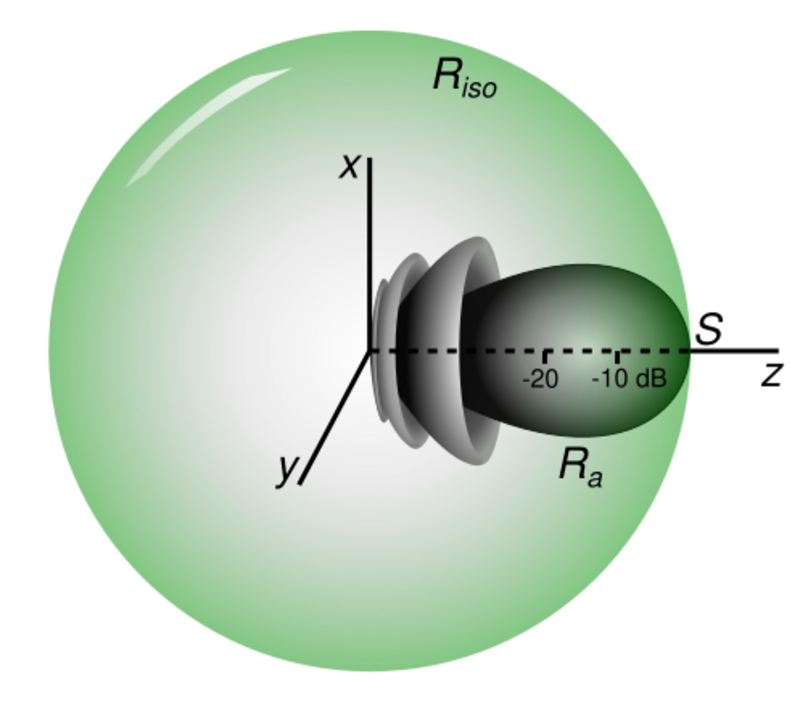
Effective radiated power HandWiki
Jan 5, 2018. Effective, or Equivalent, Isotropically Radiated Power (EIRP) is the maximum amount of power that could be radiated from an antenna, given its antenna gain and the transmitter power of the RF system. EIRP is most commonly given in decibels over isotropic, dBi. The IEEE definition for effective radiated power (ERP), which is similar.

Effective Isotropic Radiated Power YouTube
4.5.3 Effective Isotropic Radiated Power. A transmit antenna does not radiate power equally in all directions and for a receiver in the main lobe of the transmit antenna it is as though there is an isotropic transmit antenna with a much higher input power. This concept is incorporated in the effective isotropic radiated power (EIRP):
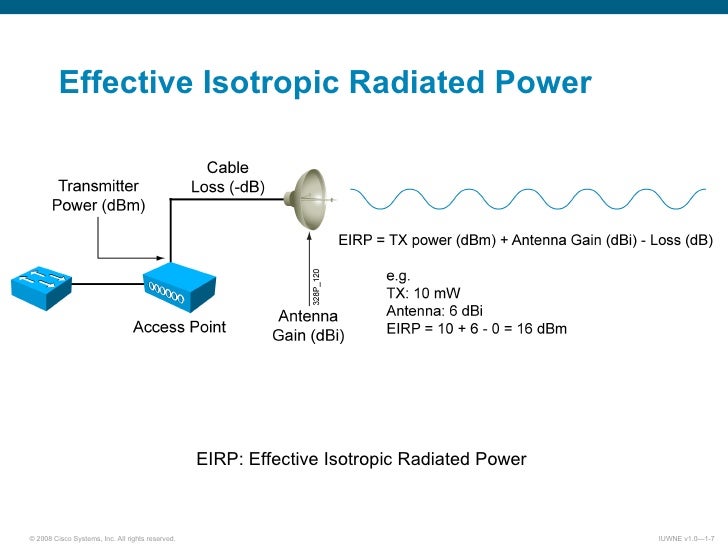
Iuwne10 S01 L03
Effective isotropic radiated power (sometimes also referred to as equivalent isotropic radiated power), is a commonly used unit when specifying antenna efficiency (gain). In order to provide a common reference for radiated power, an ideal isotropic radiator is used as the standard. An isotropic radiator emits power from a singular point.

Презентация на тему "© 2006 Cisco Systems, Inc. All rights reserved
What is Effective Isotropic Radiated Power (EIRP) - A wireless link budget, in general, estimates the possible losses that will be encountered by the signal being transmitted and adjustments are made on the design parameters to combat the effects of such losses. EIRP is commonly used in wireless link budget calculations to specify the power level req
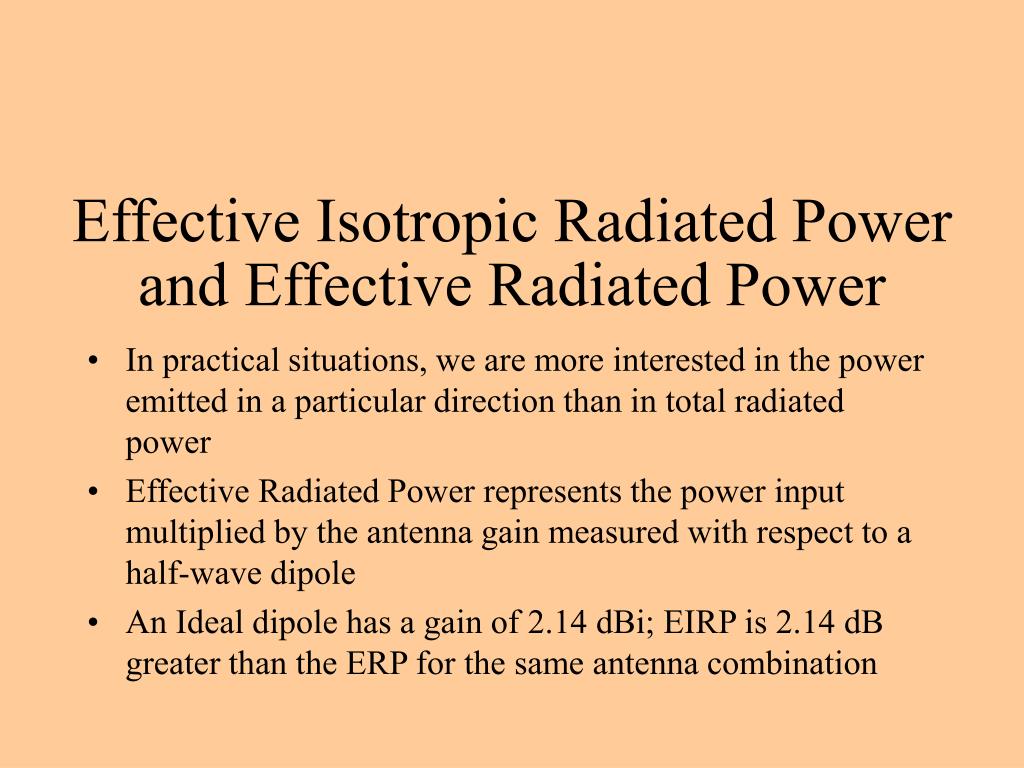
PPT bab Antenna PowerPoint Presentation, free download ID610001
EIRP (Effective Isotropic Radiated Power) is the measured radiated power of an antenna in a specific direction. It is also called Equivalent Isotropic Radiated Power. It is the output power when a signal is concentrated into a smaller area by the Antenna. The EIRP can take into account the losses in transmission line, connectors and includes.
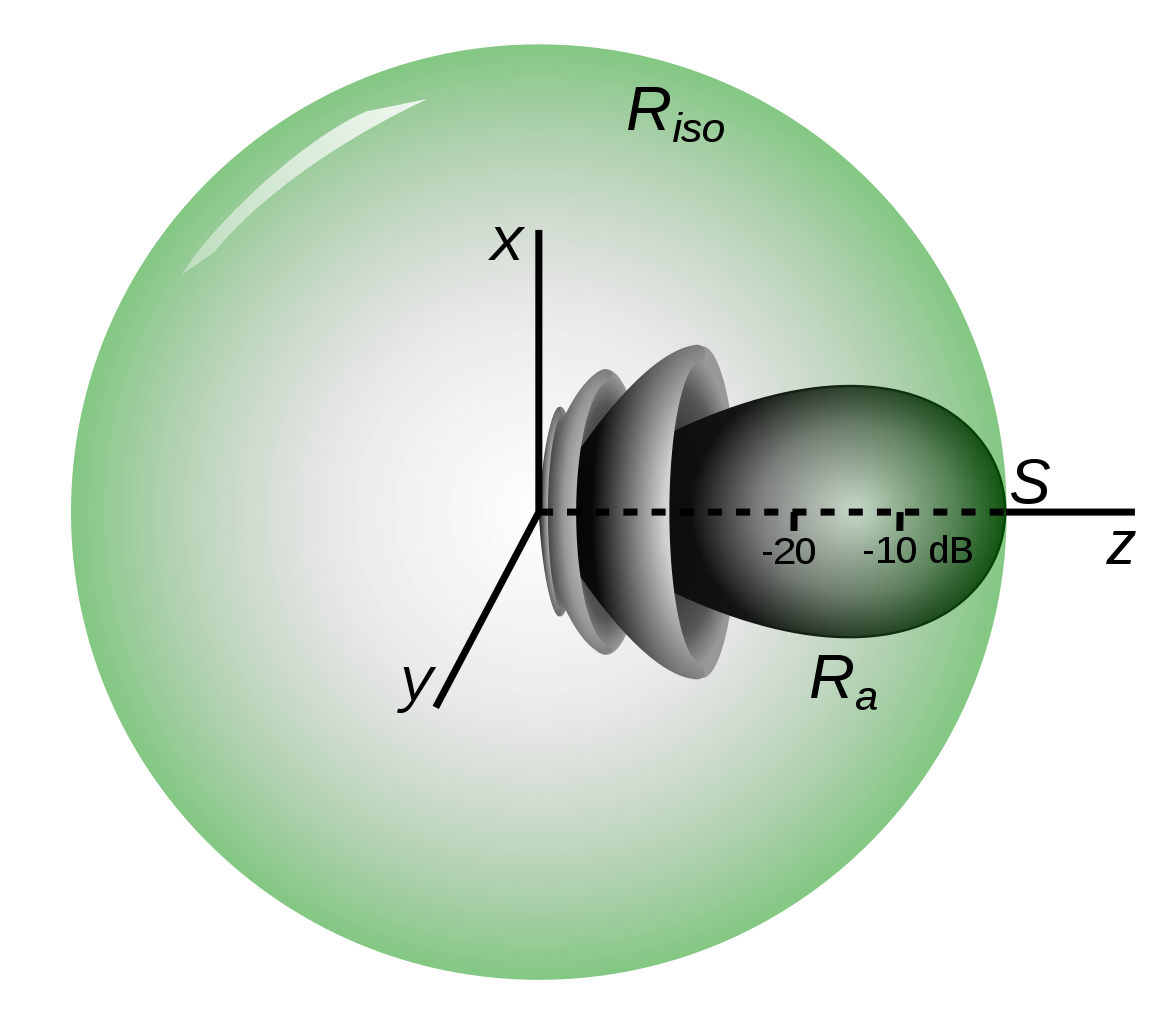
Antenna Gain dBi vs. dBd Ham Radio Academy
Effective isotropic radiated power is the hypothetical power that would have to be radiated by an isotropic antenna to give the same ("equivalent") signal strength as the actual source antenna in the direction of the antenna's strongest beam. The difference between EIRP and ERP is that ERP compares the actual antenna to a half-wave dipole.
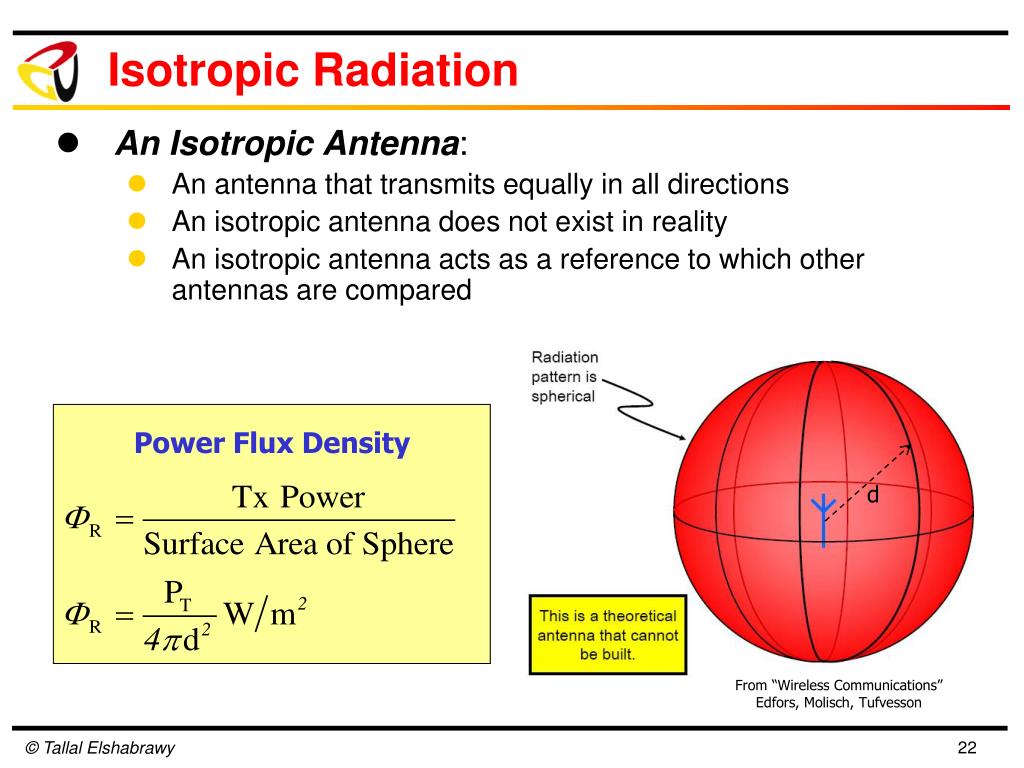
PPT NETW 701Wireless Communications PowerPoint Presentation, free
Effective Isotropic Radiated Power (EIRP) is the output power when a signal is concentrated into a smaller area by the Antenna. An isotropic radiator radiates power equally in all directions, however a perfect isotropic radiator is only theoretical as even the simplest antennas will concentrate the signal in certain direction(s). E.g. a 1/2.

11+ Effective Isotropic Radiated Power Calculation Pictures Leonard R
Effective, or equivalent, isotropically radiated power (EIRP) is a measurement of the optimum power that can be radiated from an antenna from a particular transmitter. Most often conveyed as either decibels (dB), or decibels over isotropic (dBi), EIRP is used to gauge the maximum possible radiation from an RF system, either for standards.
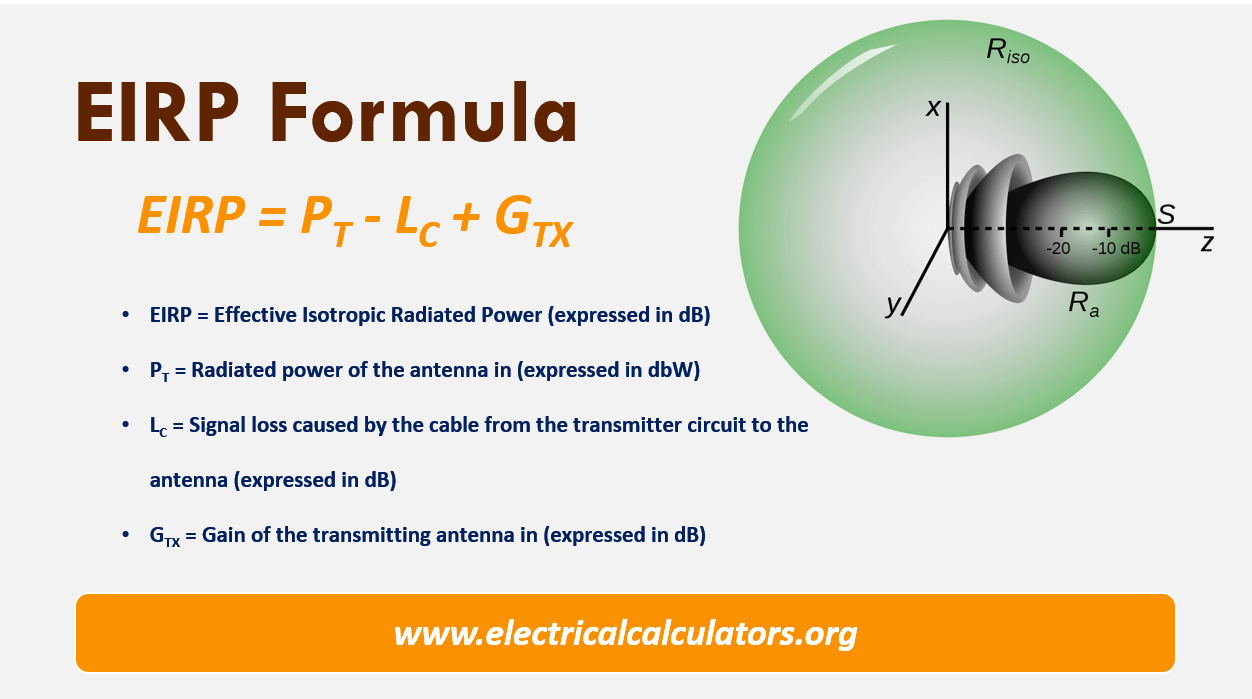
Effective Isotropic Radiated Power Formula Calculator Antenna EIRP
P d = P t / (4 π R 2) Pt is the total power radiated by the antenna. This formula works for the power being emitted by an isotropic antenna. If the antenna is a directional antenna, we need to take into account the antenna gain, and the formula used to calculate the power density is as follows: P d = ERP/ (4 π R 2) = (P t × A g )/ (4 π R 2)

Effective radiated power Wiki Everipedia
Equivalent isotropic radiated power, EIRP, is the total radiated power from a transmitter antenna times the numerical directivity of the antenna in the direction of the receiver, or the power delivered to the antenna times the antenna numerical gain.The numerical path loss is the ratio of EIRP to the power available at the receiver, which is the output of an isotropic antenna substituted for.

Use The Following Information For Questions 1 To 1...
What is the effective isotropic radiated power of a repeater station with 200 W transmitter power output, 2 dB feed line loss, 2.8 dB duplexer loss, 1.2 dB circulator loss and 7 dBi antenna gain? System gain = -2 - 2.8 - 1.2 + 7 = 1 dB ERP 200 W log 100 log (0.1) 200 1.26 252 W11

PPT ECSE 6961 The Wireless Channel PowerPoint Presentation, free
An antenna's effective isotropic radiated power (EIRP) is its power measured in one direction. It is named as such because it is the power an isotropic (perfectly omnidirectional) antenna would have to radiate to achieve the same value. This calculator is designed to compute the EIRP given the transmitter's radiated power, the loss introduced.

VHF/UHF WSPR Propagation Study
2.5.3 Effective Isotropic Radiated Power. A transmit antenna does not radiate power equally in all directions and for a receiver in the main lobe of the transmit antenna it is as though there is an isotropic transmit antenna with a much higher input power. This concept is incorporated in the effective isotropic radiated power (EIRP):
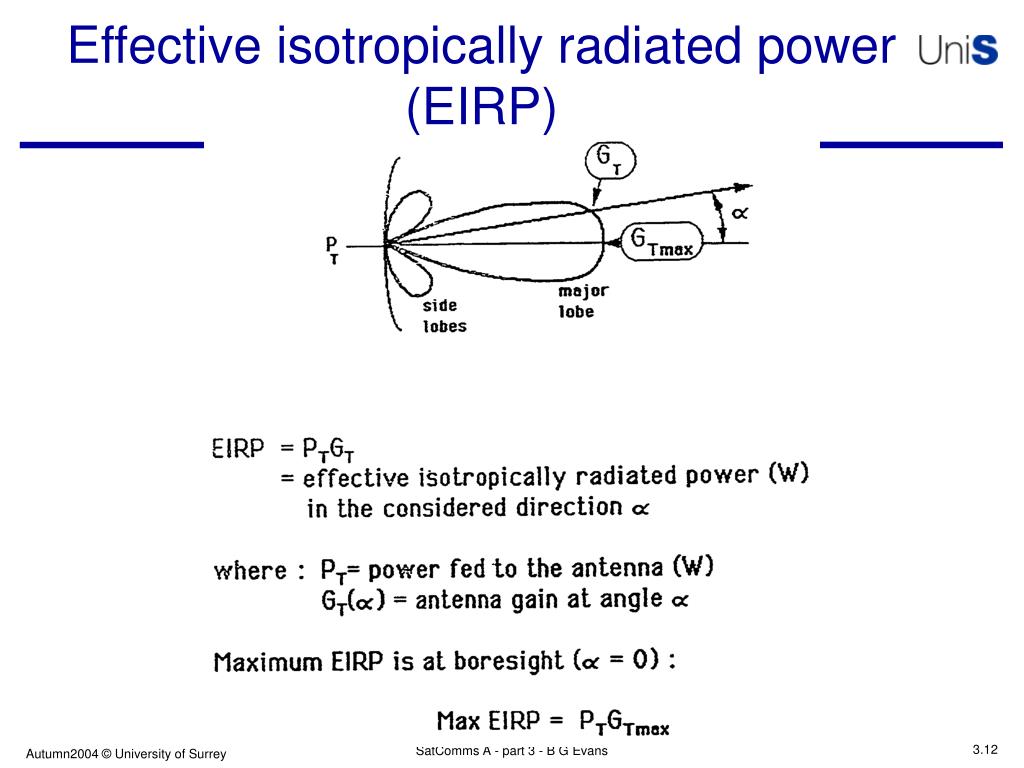
PPT Satellite Communications A Part 3 PowerPoint Presentation, free
TRP Equations. In this section, we'll relate an antenna's radiation pattern to the Total Radiated Power, along with relations for Effective Isotropic Radiated Power (EIRP) and calculating the TRP numerically. Suppose an antenna has a radiation pattern given by , where theta and phi are standard variables in spherical coordinates.The units of R are in Watts/Steradian (a steradian is just a two.

királyi család pisztoly hígított erp radar húsvéti Földön Bizonyít
and achieves an effective isotropic radiated power (EIRP) greater than 48 dBW and G/T greater than 7 dB/K. The port antenna has a hybrid function: it can support the lunar link or the DTE link, depending on line of sight conditions and mission demands. To support the lunar link function, it has a slightly larger antenna, with